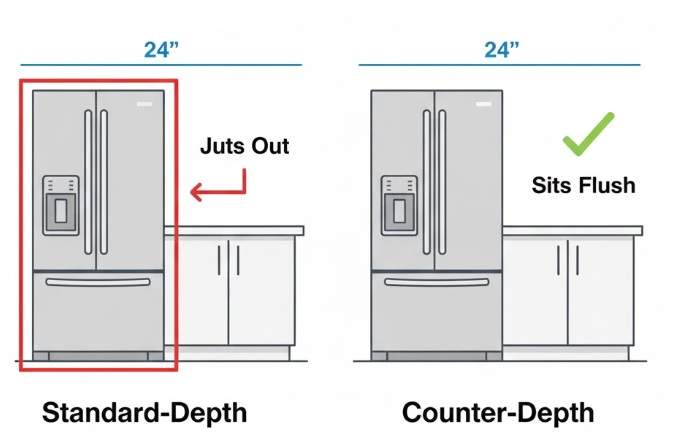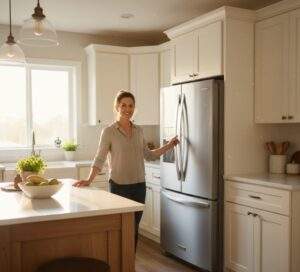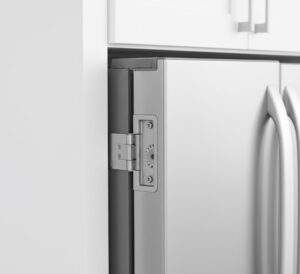Best Counter Depth Refrigerators: The Choice for a Perfect Built in Fit
Living with a small kitchen often feels like a constant puzzle—every inch counts. And nothing disrupts the flow more than a bulky refrigerator that juts out past your countertops, creating a cramped and clumsy walkway. If you’re tired of that oversized appliance dominating your space, you’ve come to the right place. We’ve delved deep into the world of modern appliances to find the very best counter depth refrigerator for a small kitchen, focusing on models that deliver a sleek, built-in look without compromising on the storage you actually need. This guide goes beyond manufacturer specs, offering real-world insights and practical tests to help you reclaim your kitchen with confidence. Whether you’re navigating apartment size refrigerator reviews or starting a full renovation, we’ll help you find the perfect fit.
How We Chose These Models
To build this list, we went beyond simple product descriptions. We knew you needed real, practical information you can trust. Our criteria for selection were strict and focused entirely on the challenges of a small kitchen:
- Strict Width Limit: We only considered models under 33 inches wide, with a special focus on even narrower options for truly tight spaces.
- Real User Feedback: We prioritized models with overwhelmingly positive user reviews, specifically looking for comments about installation and use in small or apartment-sized kitchens.
- Smart Features for Small Spaces: We looked for standout features like zero-clearance hinges, reversible doors, and clever internal storage layouts that maximize every cubic foot.
- Value and Performance: We balanced price with performance, reliability, and the high-end aesthetic you’re looking for.
Counter Depth vs. Standard Depth Fridge: Why It Matters in a Small Kitchen
Before we dive into the top models, let’s clarify the key difference. A standard-depth refrigerator can be up to 36 inches deep, often extending 6-10 inches beyond your 24-inch deep countertops. This is what creates that awkward, jutting-out effect.
A counter depth vs standard depth fridge is designed to sit virtually flush with your cabinetry, typically measuring between 27 and 30 inches deep (including the door and handles). This small change has a massive visual impact. It creates a seamless, integrated line that makes your entire kitchen feel more open, streamlined, and professionally designed. For a small kitchen, this isn’t just a style choice—it’s a space-saving game-changer.
The Top 5 Counter Depth Refrigerators for 2025
Here are our top picks that masterfully blend form and function for limited spaces.
1. Bosch 800 Series 30″ French Door (B30CN80SNS)
- Precise Dimensions: 29.75″ W x 72″ H x 28.5″ D (with handles)
- Best For: Narrow gaps of 30 inches where you want a premium, feature-rich experience.
- Real-World Capacity: At 17 cu. ft., it’s surprisingly spacious. We found it comfortably holds a week’s worth of groceries for two to three people, with dedicated gallon storage in the door and a full-width chiller drawer perfect for platters or charcuterie.
- Small Kitchen Standout Feature: Zero-Clearance Hinge. This is a massive win for tight spaces. The doors can open a full 90 degrees without swinging out past the refrigerator’s width, meaning you can place it directly against a wall and still access all your drawers.
- Pros & Cons:
- Pros:
- True zero-clearance hinge design.
- Sleek, fingerprint-resistant stainless steel.
- Excellent temperature management with dual compressors.
- Internal water dispenser for a clean exterior look.
- Cons:
- Premium price point.
- No external ice dispenser (a pro for some).
- Pros:
2. Fisher & Paykel Series 7 31″ French Door (RF170ADUSX4 N)
- Precise Dimensions: 31.1″ W x 67.5″ H x 27.38″ D (with handles)
- Best For: Kitchens that need maximum storage in a sub-32-inch width, with a focus on food preservation.
- Real-World Capacity: Its 17 cu. ft. feels larger thanks to a very flexible shelving system. The door bins are generous, and the bottom freezer is well-organized with multiple sliding trays. It’s a great choice for those who cook with a lot of fresh ingredients.
- Small Kitchen Standout Feature: ActiveSmart™ Foodcare. This technology intelligently adjusts temperature, airflow, and humidity based on your usage patterns. In a smaller fridge where space is tight, this feature is crucial for keeping food fresh longer and reducing waste.
- Pros & Cons:
- Pros:
- Exceptional food preservation technology.
- Slim profile with a very modern, flat-front design.
- Internal ice maker and water dispenser.
- Very quiet operation.
- Cons:
- Slightly wider than the 30-inch models.
- Handles add to the depth.
- Pros:
3. GE Profile 30″ French Door (PWE19KSKSS)
- Precise Dimensions: 29.75″ W x 68.63″ H x 31″ D (with handles)
- Best For: Anyone seeking the narrowest french door refrigerator from a major US brand with reliable features and serviceability.
- Real-World Capacity: This 18.6 cu. ft. model is the storage king on our list. The internal layout is traditional but effective, easily handling bulky items like pizza boxes and large juice containers.
- Small Kitchen Standout Feature: Compact French Door Design. It’s one of the few models under 30 inches wide that offers the popular French door configuration. The shorter door swing is a natural advantage in narrow kitchens compared to a single-door model.
- Pros & Cons:
- Pros:
- Excellent capacity for its width.
- Fingerprint-resistant finish is a practical touch.
- Internal water dispenser and factory-installed ice maker.
- Good value for a French door model.
- Cons:
- Deeper than other models on this list.
- Requires more side clearance for doors to open fully.
- Pros:
4. Summit 24″ Bottom Freezer Refrigerator (FFBF249SS)
- Precise Dimensions: 23.63″ W x 78.75″ H x 25.25″ D (cabinet depth)
- Best For: Truly tiny kitchens, apartments, or ADUs where every millimeter counts.
- Real-World Capacity: At 11.5 cu. ft., it’s built for essentials. It’s perfect for a single person or a couple who shops frequently. You can fit a gallon of milk in the door, and the crisper is adequate for a week’s worth of produce.
- Small Kitchen Standout Feature: Ultra-Narrow 24-Inch Width. This is a true apartment-sized refrigerator. Its slim footprint can fit into spaces where no other model can, and the reversible door hinge adds crucial installation flexibility.
- Pros & Cons:
- Pros:
- Extremely narrow to fit in the tightest spots.
- Reversible doors for ultimate placement flexibility.
- Frost-free operation is a plus in this size class.
- Sleek European styling.
- Cons:
- Limited overall capacity.
- No ice maker or water dispenser.
- Pros:
5. Haier 28″ 4-Door French Door Refrigerator (HRQ16N3BGS)
- Precise Dimensions: 27.95″ W x 71″ H x 26.5″ D (without handles)
- Best For: Those who want maximum organizational flexibility in a footprint under 28 inches.
- Real-World Capacity: Its 16.4 cu. ft. is cleverly divided into four zones. This layout is fantastic for separating items—drinks in one section, produce in another. It prevents you from having to open the entire fridge just to grab one thing.
- Small Kitchen Standout Feature: Quad-Door Design. The four-door layout minimizes the door swing radius more than any other design, making it ideal for narrow galley kitchens where you might be standing right in front of the fridge.
- Pros & Cons:
- Pros:
- Extremely flexible storage options.
- Minimal door swing is perfect for tight walkways.
- Sleek, modern aesthetic.
- Good energy efficiency.
- Cons:
- Individual compartments are smaller.
- May not fit very large items like party platters.
- Pros:
Final Verdict: Which Counter-Depth Fridge is Right for Your Kitchen?
Choosing the right appliance can feel overwhelming, but it comes down to your specific space and needs. Here’s a quick breakdown to help you decide.
- Best Overall: The Bosch 800 Series 30″ is our top pick. Its zero-clearance hinge is a true problem-solver for small kitchens, and its premium build quality and performance justify the investment. It’s the best counter-depth refrigerator for a small kitchen if you want a perfect blend of style, function, and smart design.
- Best for the Tightest Budget: The Haier Quad-Door offers incredible flexibility and a modern look at a more accessible price point.
- Best for Narrow Spaces: The Summit 24″ is the undisputed champion for extremely narrow gaps where no other model will fit.
Frequently Asked Questions (FAQ)
What’s the main difference in storage space between counter depth and standard-depth?
While they have the same external width, counter-depth models are shallower, so they typically have about 10-15% less internal cubic footage than their standard-depth counterparts. However, manufacturers have become very clever with interior design, using flexible shelving and smart door storage to maximize usable space.
Are counter depth refrigerators significantly more expensive?
Yes, they often carry a price premium of 10-20% over standard-depth models of similar size and features. You are paying for the specialized design, sleeker aesthetics, and the “built-in” look that solves a major design problem in the kitchen.
I can’t afford a new fridge. Is there a way to make my regular fridge look counter-depth?
Yes! One popular design trick is to build a deeper enclosure or pantry cabinet around your existing standard-depth refrigerator. By bringing the surrounding cabinetry forward to be flush with the fridge doors, you can create a custom, built-in look for a fraction of the cost of a new appliance. This is an excellent solution for how to make a regular fridge look counter-depth.
How much clearance space does a counter depth fridge need around it?
Always check the manufacturer’s specifications, but a general rule of thumb is to leave at least 1/2 inch on each side, 1 inch at the top, and 1-2 inches at the back for proper air circulation. This is crucial for the compressor to work efficiently and prevent overheating.
[Supplementary File] The Counter-Depth Refrigerator A Detailed Buyer’s Technical Guide.PDF
Hi, I’m [jeybee]. As a long-time resident of Seoul, I’m passionate about uncovering the authentic, everyday magic of Korea. This blog is my way of sharing my favorite spots, tips, and cultural insights with you, beyond the usual tourist traps.




